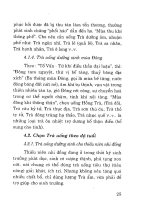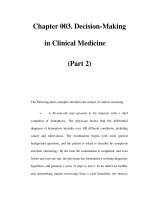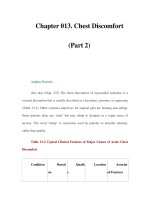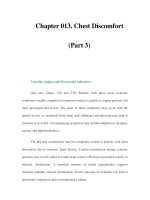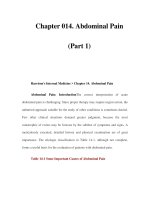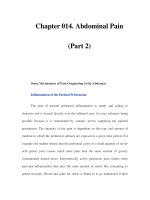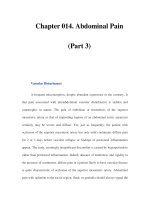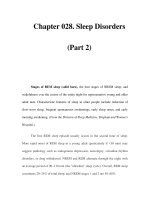Chapter 089. Pancreatic Cancer (Part 2) pdf
Bạn đang xem bản rút gọn của tài liệu. Xem và tải ngay bản đầy đủ của tài liệu tại đây (96.19 KB, 6 trang )
Chapter 089. Pancreatic Cancer
(Part 2)
Physical Findings
Patients with early disease may not have any significant abnormalities
detectable on physical examination. Jaundice may be a presenting feature in some;
in these patients a palpable, nontender gallbladder (Courvoisier's sign) may be
palpated under the right costal margin. Patients with more advanced disease may
have an abdominal mass, hepatomegaly, splenomegaly, or ascites. The left
supraclavicular lymph node (Virchow's node) may be involved with tumor, or
widespread peritoneal disease may be palpable on rectal examination in the pouch
of Douglas.
Diagnostic Procedures
Imaging Studies
(Fig. 89-1) Ultrasound is often used as an initial investigation for patients
with jaundice, or with less-specific symptoms such as upper abdominal
discomfort, and is able to assess the biliary tract, gall bladder, pancreas, and liver.
Computed tomography (CT) scanning is preferable to ultrasound even though it is
more costly, as it is less operator-dependent, more reproducible, and less
susceptible to interference from intestinal gas. The sensitivity and specificity of
CT is markedly improved by the use of pancreatic protocol scanning on modern
multislice scanners. CT may show a pancreatic mass, dilatation of the biliary
system or pancreatic duct, or distal spread to the liver, regional lymph nodes, or
peritoneum (and/or associated ascites). When helical CT is combined with the use
of intravenous contrast, it may also help determine resectability by providing
information on the involvement of important vascular structures such as the celiac
axis, superior mesenteric or portal vessels. Endoscopic retrograde
cholangiopancreatography (ERCP) is also widely used in the diagnosis of
pancreatic cancer, particularly when CT and ultrasound fail to show a mass lesion,
and may reveal either stricture or obstruction in either the pancreatic or common
bile duct. ERCP can also be used to obtain brushings of a stricture for cytology or
for placing stents in order to relieve obstructive jaundice. Endoscopic ultrasound
(EUS) may be useful in the diagnosis of small lesions (<2–3 cm in diameter) and,
in some cases, for local staging as well as evaluating invasion of major vascular
structures. EUS-guided fine-needle aspiration may also be used to obtain cytology
for confirming the diagnosis, particularly in patients with potentially operable
disease (see below). While magnetic resonance imaging (MRI) does not offer any
advantages over CT in the routine evaluation of patients with possible pancreatic
cancer, magnetic resonance cholangiopancreatography (MRCP) may be better
than CT for defining the anatomy of the pancreatic duct and biliary tree, being
able to image the ducts both above and below a stricture. The sensitivity of MRCP
is comparable to ERCP, but does not require contrast administration to the ductal
system, so that there is less associated morbidity. MRCP may be useful when
cannulation of the pancreatic duct by ERCP has been unsuccessful or may be
difficult, such as when normal anatomy is changed by surgery. Positron-emission
tomography with
18
F-fluoro-2deoxyglucose (FDG-PET) may be useful for
excluding occult distal metastasis in patients with localized disease who are being
worked up for surgery or in patients with unresectable localized disease being
considered for chemoradiotherapy.
Figure 89-1
